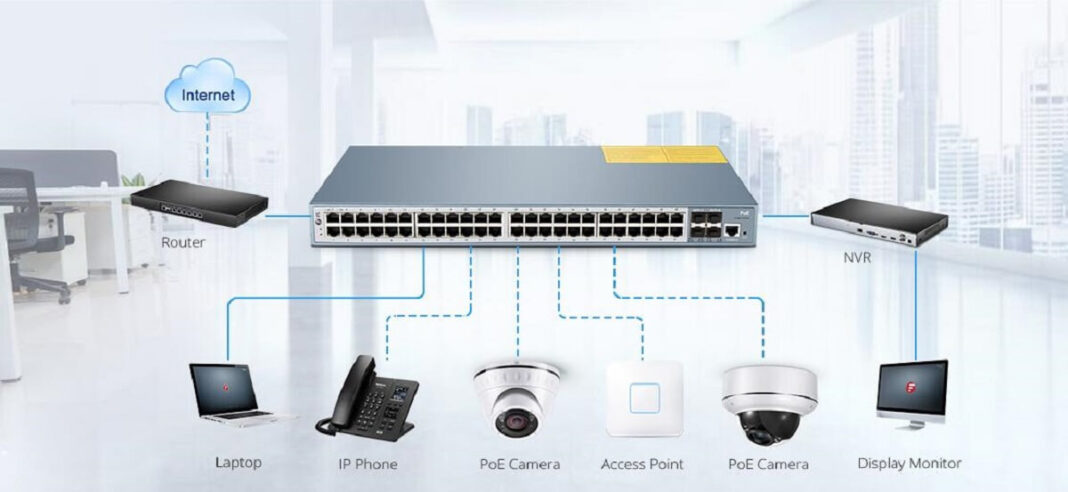A network switch is a crucial component of networks based on Ethernet. It offers several technical benefits over less sophisticated devices such as ethernet hubs.
To work, a switch identifies each device by its 48-bit media access control (MAC) address and builds a table of those addresses as received. This allows the button to filter out bad or misaligned data frames and forward them to their destinations.
Basic Functions
When a switch receives a frame, its software looks at the MAC address and maps it to the port that leads to the device with that destination MAC address. The switch keeps this mapping in a table of MAC addresses, constantly updating and maintaining. This is how the button “learns” what stations are reachable over which ports.
So, what is an ethernet switch? Ethernet switches operate at the data link layer of the OSI model. They receive packets and then house them in frames, arbitrary information sequences containing 48-bit media access control (MAC) addresses, and other fields. Then they forward the edges to the Ethernet devices that need them based on their destination MAC addresses. This process is known as bridging.
If the switch sees a frame with a destination MAC address that isn’t in its MAC address table, it sends that frame to all ports except the one it received it on (this is known as flooding). It hopes that the device using that MAC address will respond, and then the switch can add an entry for that station to its MAC address table.
Ports
Using Ethernet switch ports, network devices can connect. The switch takes physical connections from computers and external devices and then routes data using packet switching. It comes in various types, allowing you to customize your network for different uses.
Ethernet switches are much more sophisticated than hubs, which cannot distinguish between devices and cause performance issues when multiple devices use the same bandwidth simultaneously. A controller can make intelligent decisions on which device to send data to, which helps ensure that every connected device has access to the total bandwidth available.
A network switch compares 48-bit media access control (MAC) addresses to create a list of devices on which each port is reachable. It then filters and forwards packets based on these lists, which can reduce the amount of network traffic that gets sent around the LAN, improving performance. This functionality is referred to as bridging.
Port Types
Different types of Ethernet switches are available depending on your network’s requirements. Buttons vary in speed – from 10/100 Mbps to Gigabit – and can be unmanaged or managed. The number of ports on a switch is another factor to consider.
Each port on an ethernet switch is assigned a unique 48-bit media access control (MAC) address. As the controller receives frames, it compares them to this list of addresses. The structure is forwarded to the destination workstation or device connected to that port when it finds a match. This reduces the data transmitted around a network by limiting what is delivered to its intended destination.
Switches can do this because of their architecture. They have a root and designated ports. These ports determine how a controller is configured regarding its Spanning Tree Protocol (STP). The other ports on the switch block these ports. This prevents loops in the network and ensures that only one link is used to transmit data.
VLANs
Each VLAN operates as a virtual bridge that isolates network traffic for the specific group of devices it represents. A device in one VLAN cannot communicate directly with a device on another VLAN unless passed through a router.
The switch adds a VLAN tag to each frame it forwards to separate network traffic by VLAN. The VLAN tag contains key identifying data, such as the source MAC address and the destination MAC address. This information is read by the devices on the network and used to determine where the packet should go.
The ethernet switch also performs basic network layer two functions, such as address learning and forwarding/filtering. It also prevents loops in the network by running a spanning tree protocol, which uses a distributed algorithm to form a path between switches.
The spanning tree protocol determines the shortest path toward the root based on link weights and blocks links not part of the spanning tree. This reduces congestion and improves the performance of protocols. The spanning tree protocol can be improved through advanced features such as rapid spanning tree (RSTP), which minimizes the convergence time when there is a topological change.
Management
Ethernet switches are among the most common pieces of IT equipment. They can be found in home-based local area networks, small businesses, and enterprise applications. Understanding how these devices function can help technical and procurement professionals make informed choices when selecting a switch for their network.
A vital aspect of an Ethernet switch is how it manages traffic between connected devices. Each switch port operates as a separate collision domain from other ports on the device. This helps to reduce data packet transmission delays and congestion within a network.
Read Also: Aesthetic Window Ideas for Your New Home
To accomplish this, an ethernet switch decides which devices are on which network segments based on the 48-bit media access control (MAC) addresses used in LAN standards. As frames are received on a switch port, the software in the device looks at the source address and adds it to a table of MAC addresses that it maintains.
To ensure that stations can reach each other, an Ethernet switch also performs forwarding. If a frame is not directed to any of the switches ports, the software in the device sends it out to all the ports except the one it received it on. This is known as “frame flooding.”


